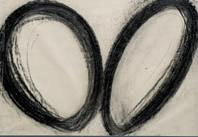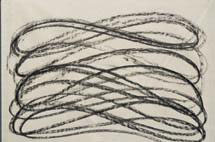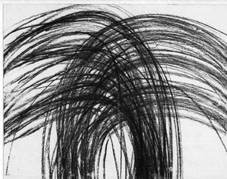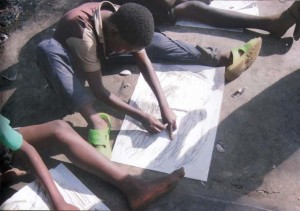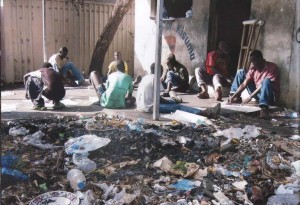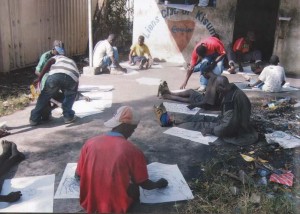Research & Cases
Research at the Training Institute for Art Therapy, Utrecht, the Netherlands
- Margareth Barten / Art Therapist / mbarten@upcmail.nl
After my training I started using the method with adults. I have worked on a psychiatric ward for many years.
I first offered an exercise from the method of ‘the Timeless Hour’ to a patient I was counselling individually.
What greatly surprised me was that after the exercise she was able to explain in detail her inner experiences during the exercise.
What she told me corresponded exactly with the aim of the exercise as described in the book. Comparable experiences have occurred more than once, giving me confidence that these exercises are healing in many respects.
As of 2013 I will be working in education, teaching children with the method of ‘the Timeless Hour’.
‘Client in therapy drawing with the non-dominant hand (normally she is left handed) and holding a piece of clay in her left hand for support in feelings / Finland’.
This picture shows a client sitting down and carrying out an exercise from ‘the Timeless Hour’.
She is drawing with her non-dominant hand, causing her emotional side to be addressed more.
In daily life she has been conditioned out of her left handedness. In the other hand she is holding a piece of clay which can give her more security and stability. Clay is one of the oldest materials on earth and can enforce the above mentioned feelings. Through feeling the clay in her hands the client can access her body feeling better. This makes her able to express her deep inner images more spontaneously in her drawings.
Margareth Barten
- Naqiba Bergefurt / naqiba@planet.nl
Art therapist
Subject: Research in Amsterdam
Research into the method of ‘the Timeless Hour’ described by author Michiel Czn. Dhont in his book with regard to its possibilities for Art Therapy; a case study with regard to its merits for immigrant children with developmental problems.
On the Author of this research
Naqiba Bergefurt (1954) studied pedagogy at the University in Utrecht, the Netherlands and has worked with children in various locations, including children requiring special care and in a development project in New Delhi, India.
She has trained herself in visual arts, especially painting and did the training in Art Therapy given by Annette Brederode in Amsterdam, the Netherlands.
‘The Timeless Hour by Michiel Czn. Dhont’
She has also studied at the Studio Molenpad Workplace founded by Michiel Czn. Dhont in Amsterdam , the Netherlands.
With this study Naqiba has concluded her training at the Art Therapy Institute in Utrecht, the Netherlands.
On the research group
The study was carried out at a primary school where over 80 % of the children have an immigrant background. All these children have language problems and many of them also have social-emotional problems as a result of their not being integrated into the Dutch culture.
The girls often show a lack of self-respect and self-confidence, resulting in a withdrawal from or an over-adaptation to the group.
The boys cover up their lack of respect by acting up or non-adaptation in their behaviour.
Planning of the sessions
The course consisted of nine lessons, one hour weekly, to a group of five children, 8 to 10 years of age. At each session, one or two exercises from Michiel Dhont’s method were given. The first three lessons were used as a kind of diagnostic period.
After that I made my choice with regard to the kind of exercises based on my observations of the children and their way of dealing with their problems.
In the same way I have made certain adjustments to the way the exercises are offered.
I gave them only individual instructions, mainly at the basic level. There were five drawing lessons, the other four times we worked with clay.
In order to also involve the social aspect, I gave them a group-warming up at the beginning of each lesson.
Outcome of the research
All the children were out of balance in one way or another.
The basic drawing exercises are a very good diagnostic instrument to show tensions or lack of structure.
In two of the children I saw too much tension (also physically) and great problems in finding cohesion and inner direction. By the end of the course both children had become more relaxed, calmer and more self-directed.
Another girl was too fat, very passive and dependent, showing no emotion or expression.
By the end of the course she had lost weight, was much more alert, responded in her own way and put herself first.
The fourth girl, who was very silent and controlled, broke through her role pattern and rebelled and relaxed.
The only boy in the group felt frustrated, which was more due to his temporary situation than to any personality problem (he had only recently arrived in the Netherlands). He was not motivated to follow the therapy and quit after four times. His drawings showed no inner turmoil, in the way the drawings of the girls did.
After the boy quit the girls became more relaxed and enjoyed what they were doing more!
For more information on this theme / research please end an e-mail to:
Naqiba Bergefurt / naqiba@planet.nl
- Silvia Fiorini / art therapist / fiorini.silvia@gmail.com
Reaction by art therapist Silvia Fiorini to a workshop ‘the Timeless Hour’.
Some time ago, during the Art Therapy training in Leiden / the Netherlands I did a few exercises in visual expression which come from my experiences with the method ‘the Timeless Hour’, during a workshop at your studio.
These have been very useful to me. They have helped me in taking important decisions.
Currently I am in an internship at a school for special education for children with severe learning disabilities. I have your book ‘the Timeless Hour’.
I am wondering to what extent these exercises are applicable for children with severe learning disabilities and am interested in the experiences gained with this up till now.
I am planning to try out a number of exercises, among other things in combination with the drawing of shapes. This might become a good research project for the thesis which I am going to start after this internship.
Are there any further courses about this aimed at working with children? I must say that the book gives a lot of information and I think it is a matter of experimentation. Courses about this matter could make people more enthusiastic and provide inspiration.
Silvia Fiorini.
- Luciette van Hezik / Art therapist / luciettevanhezik@zonnet.nl
Luciette is working in a partnership, combining verbal and/or body therapy with expressive art therapy.
Dear Michiel,
Below my experience and vision regarding your methodology.
‘Session Creative Therapy in Finland. Expressive drawing and painting (picture) with both hands in expressing and processing inner tensions. A woman paints through visual expression out of movement and intuition during a session in Finland.’
I want to offer an example of the counselling of adults, where drawing out of movement and modelling with clay have had far-reaching results through a combination with Social Art Therapy.
In an individual counselling I met a woman who had the feeling that she was stuck in a set pattern in her life, and where verbal therapy did not provide the desired results.
Out of the basic locomotion I guided her to the swaying balance movement, where she herself felt the need to work towards ‘The writing”, specifically the staccato.
In the alternation of staccato and melodic movement, memories and images began to surface of an isolation chamber where she had spent time 16 years ago when she was admitted due to post natal depression.
Feelings of powerlessness, sadness and anger surfaced, but also her expression of power, which surprised her and also gave her a liberated feeling.
When I asked her which animal she could experience in this, she modestly indicated a cat, but in reality is was more like a lion!
Through the task out of expressive art therapy to build a lion out of yellow clay, she has step by step been able to give a form to her ‘snowed under power’ and has integrated it into her daily life.
Another possibility for me to integrate Michiel Dhont’s method is in learning to express my own individuality. As my thesis I want to do a study into the effect of using both hands as well as only the right and left hand with all the visual techniques of expressive art therapy to stimulate both halves of the brain which can occasion a complete harmonisation of man in his healing process.
Read more about Luciette’s work
Josée van Schuppen / info: info@joseevanschuppen.nl and www.joseevanschuppen.nl
Visual artist and teacher/therapist method ‘the Timeless Hour’
‘I did various courses Visual Expression out of movement and intuition with Michiel. To me it was a revelation. Ever since then I have been painting with my hands which I see as an instrument of my heart. In this way I stay closer to my emotions and keep both feet on the ground. ‘
Josée: ‘There is nothing you have to do, everything you do is fine’.
‘Action painting and drawing with closed eyes is an exciting adventure and wonderful to do. When I am painting or drawing I forget everything around me. My paintings and drawings are usually full of movement but sometimes very still. I often use sand, rope or wood to express my connection with nature. I often run workshops “Enjoy yourself with with the motto: “” there is nothing you have to do; everything you do is fine”.
I often notice that there is too much that adults as well as children themselves or their environment feel they have to do. This seems a shame to me, because striving towards a result often blocks creativity.
I think that I am going to call a work I have just done ‘the Timeless Hour’. The funny thing is that I usually paint for one hour at a time and it then seems like only five minutes.
- Cas Rooseboom teaching in Kenya / Africa with ‘the Timeless Hour’ / cas@casrooseboom.nl
For a number of years Cas has been working in Kenya and Tanzania for certain periods of the year. There he trains primary school group teachers and artists in which he also uses the method of the Timeless Hour. In addition he works with street kids in the slums of large cities like Nairobi.
Real creativity improves the feeling of self-esteem and the ability to transform accountability into new and positive behaviour. A brief report of an example Cas tells us about:
‘A boy from a deprived area had attended one of my courses (see the pictures). A year later I ran into the same boy in Nairobi, now wearing decent clothes. I address him and ask him what he has been doing since last year. The boy tells me he had found out he wanted to do something on his own. He had taken the initiative and had approached a company to get a job. This had worked out and for the first time in his life the boy had earned his own money at that company.
This literally turned out to be the result of the experiences through visualising sessions of the course with that group of boys a year before’.
- 7. Gerard Dirks / gerarddirks@hotmail.com
Gerard Dirks is primary school group teacher and the director of the primary school where the You Tube film was shot which accompanies the book on DVD.
He is the teacher who, as a result of his experiences with ‘the Timeless Hour’, went back to his work as a therapist for autistic children.
“Out of my 25 years of experience as a primary school teacher and manager I recommend the book ‘the Timeless Hour’. It helps develop the children’s personality. It’s an extra and basic dimension. Based on my experiences with the method from ‘the Timeless Hour’ I have decided to go back to my original work as a coach to autistic children, using this method. “
‘Two 12 year old girls exchanging their balls of clay. Feeling the differences in weight, humidity, temperature and volume of each other’s ball of clay. Experience based exercise in communication in a playful manner. The girls also exchange the balls of clay up to six or eight times with other children in the class. Each time they experience the differences. The early discovery of mutual similarities and differences causes children to learn how to deal with mutual differences at a young age through playful exercises. This may contribute to the prevention of discrimination with regard to differences within a multiform society at a later age.
- Joke Zonneveld / visual artist and teacher; in cooperation with Irma Vroegop works with children in the ages between 4 and 12
For more information see: www.jokezonneveld.nl and www.ikvolgje.nl
‘Children in concentration during exercises from ‘the Timeless Hour’ in a group lesson by Joke Zonneveld’.
Joke Zonneveld / info@jokezonneveld.nl
Joke is a former student of the Michiel Dhont´s studio Molenpad Workplace in Amsterdam.
Joke´s series
7 ‘let the clay wake up’
15 ‘deep concentration’
20 ‘feeling the clay’
21 ‘a safe place’
40 ‘drawing’
Joke:
These are pictures of a session with small children in my own Art studio and also at a primary school. During these sessions I have used various exercises from the method ‘the Timeless Hour’ in many ways. I coach the children in my groups in visual expression out of movement and intuition, which are processes during which the children often can release tensions caused by stress and in this way improve their ability to concentrate. Through this I see the children become more free, more empathic and more creative in their behaviour.’
Joke also provides school classes with the opportunity of coming to her art studio in Uithoorn for part of the day and then uses the exercises from ‘the Timeless Hour’.
Non-violent communication
In cooperation with Irma Vroegop she offers preparatory lessons at the school on the same theme, linked to exercises around “non-violent communication”.
In both activities “letting go of judgement” plays a major role.
In addition she gives painting lessons for adults, in which the exercises from ‘the Timeless Hour’ form a large part.
More information: www.jokezonneveld.nl and www.ikvolgje.nl
- Research for the Institute for Child and Justice in Amsterdam, the Netherlands
Annette Jasperse / former student of the Michiel Czn. Dhont’s studio Molenpad Workplace
‘Girl during therapy doing a claying exercise. Holding clay in its hands can give the child a feeling of security and more stability’
Annette Jasperse / annette.j@daxis.nl / teacher expressive arts and working with the method ‘the Timeless Hour’
Over a period of six weeks with one afternoon session of three hours a week, Annette Jasperse, with supervision by me, has carried out research into the question from the judge: “Can and should the daughter of a divorced man living elsewhere on his own visit her father?”
This is a right that in principle every father has after a divorce. The judge ordered the Institute for Child and Justice to clarify this on the basis of research.
The first three joint drawing sessions at the location of Child & Justice with the mother, new boyfriend, brother and the six year old girl, already made some things clear.
In the last three claying and drawing sessions in which the girl concerned was alone with Annette, the claying sessions as well as all the drawings and the dialogue between the girl and the drawings she had made, after observation gave an even clearer picture.
The final judgement, arrived at in dialogue between the director of the Institute for Child and Justice, Annette and myself, lead to a negative advice to the judge.
The diagnosis through the method ‘the Timeless Hour’ had convinced the judge. The verdict was that the father was not awarded visiting and meeting rights with his daughter in view of previously shown irresponsible behaviour.
- Hanneke Dingemans
The experience of a student in the Studio Molenpad Workplace through one of the expressive sessions from ‘the Timeless Hour’.
Some years before I came to paint with Michiel I had done an art therapy training. There I was unable to come into direct contact with my own inner images through expressive processes. Within the training course there was no room to do so.
It was a relief to experience the freedom of painting in ‘the Timeless Hour’ method. According to Michiel everything is good in origin as I have expressed it!
One of the most remarkable occurrences happened as follows:
At the studio Michiel offered us a specific exercise called the Archaic Script. After the script all of us also made a drawing with our eyes closed, at which we could later continue drawing with our eyes open.
During the exercise music was playing which consisted of rhythmic primal sounds with singing, various sounds and drums.
At the end of this session the drawing process was evaluated individually by all of the students through a dialogue with our drawings. In my dialogue with my recently made series of drawings the shape and significance of a power animal emerged. In this case the power animal emerged as the ‘Samoyede’. Within shamanism the power animal is a well known phenomenon where the human being takes example and experiences power from a certain animal. This is also a well known phenomenon from the dream world.
Until then shamanism was an unknown vision for me and I had never gone into it. I may have heard about it at some point, but it was really also something for which I experienced a kind of boundary crossing, unreasonable fear, although I have immersed myself in astrology, chakras and many other esoteric subjects.
However, during the above described painting activity I effortlessly came into contact with a Samoyede, giving me a vague feeling of: “then this must be my power animal”.
Over the following weeks I did not pay much attention to this until I was walking over a moonlit quay with a friend in Amsterdam on our way to a concert by the jazz formation O.BA.O. in which Michiel is a double bass player. On the quay a couple came walking towards us with a small white Samoyede, which in passing reminded me of the moment in the drawing process at Michiel’s studio.
But what has occupied me most up till now was a request from the same friend several weeks later if I would look after his dog for a week. Perhaps I should mention here that I have never owned a dog myself and also do not have a pronounced preference for dogs.
Up to the moment that the dog entered my home I did not even know what kind of dog it was going to be and I got a bit if a shock when I saw it … a large white Samoyede. My power animal had come to meet me. We spent a week together. This has meant a lot to me.
This is the continuation of my experience with the Samoyede; synchronicity
Some time later … it may have been about two years … the book ‘The Tzolkin’ came my way. The Maya were able to experience the connection between the universe, the earth and mankind. This is reflected in the energetic matrix called ‘The Tzolkin’ . This matrix provides the connection of each of us with the universe as a weaving pattern of creation which is independent of time and space. When I looked up in the matrix what my “Kin”is, it turned out to be a White Magnetic Dog, confirming my link to the white Samoyede as a power animal. In this way everything comes together.
Addendum by Michiel Czn. Dhont
Through working in an expressive intuitive way at drawing and painting via the method ‘the Timeless Hour’ (in this case the exercise the Archaic Script) a creative stream develops out of the subconscious which eventually can result in a more conscious experience and/or recognition, as in this case with the Samoyede.
The book het Slimme Onbewuste (the Clever Subconscious) by Ab Dijksterhuis clearly shows that subconscious knowledge is an enormous source of power and provides significance. Experiencing quality and mental clarity can deepen, enrich and balance human existence.
- Rachel Frankenhuis / Art therapist and teacher – (among others children of asylum seekers)/ rachelfrankenhuis@planet.nl
Rachel Frankenhuis has worked a great deal with children of asylum seekers with the method ‘the Timeless Hour’.
Together with Inge Langendijk-Cissé & Jan Baan she has also developed the teaching method ‘Applaus voor jezelf (Applause for yourself)’ for the enhancement of the emotional competence of children in the ages of 4 to 7.
As teachers have observed that many 4 to 7 year old children of asylum seekers exhibite behavioural and emotional problems, Pharos has developed ‘Applause for yourself’ for the lower primary school.
- Jos Albas / an experience of a student of Michiel Dhont
‘Timeless working provides energy and passion’.
In 2005, after a grest number of years, I made contact again with my own expressive ability with visual artist Michiel Dhont. The creative expressive process out of movement and intuition that was then opened up now forms a foundation for my way of life. In 2010 I once again did an expressive course out of movement and intuition with Michiel Dhont.
For me the expressive process is a wonderful medium that in safety offers space for the exploration of the emotions within me.
I have experienced that through my hands I can make visual contact with my whole body with the emotion of what is going on at that moment. The offering of various meditation techniques, expressive exercises and group dynamics, has made me aware of the effect on my own expressive process.
By regularly distancing myself from my expressive dynamics, I have seen my emotions change during my expressive work. During that distancing I was able to go through a process of transformation through the dialogue with my image and through the guidance by Michiel Dhont.
During the dialogue with my image and through this transformation space, clarity, insight and consciousness are developing within me on all kinds of levels.
Finally making the Mandala in combination with the medicine wheel on the beach in Greece has touched me deeply. In creating the Mandala I was able to process old burdens and obstructions and to put my wish for the development of my consciousness in the world. I have experienced the unity in shape and the process of imagining the Mandala as a very powerful and cleansing ritual with a great power to straighten out my body and mind.
The renewed clarity and insights give me energy and passion, they are the corner stones for reflection and action in my daily life at home, my social environment and at work.
I am very grateful that I have been able to experience it in this way. Warm greetings, Jos.
‘Exercise out of observation after a nude model. Drawing with the dominant and non-dominant hand Making a shape and placing it in space on the drawing paper appears to be much easier to realize’
Karel Kindermans / karel@kindermans.nl
Teacher of drawing from a model at the Willem de Kooning Academie in Rotterdam
Below are experiences with visual processes from ‘the Timeless Hour’ as set down by teacher Karel Kindermans at the Willem de Kooning Art Academy in Rotterdam, the Netherlands
Even though it is not a therapeutic setting at this art academy, it does show how and in which way the visual processes can provide people with an insight in themselves and how they can discover their creative life energy and expand and deeped their abilities.
Different than usual
‘This was the moment, halfway through the module where one had strayed from the narrow path to arrive in the meadow’.
Karel:
‘During a module drawing to model at the Willem de Kooning Academy I had students in front of me with a wide variety of study backgrounds. The group comprised students of nursing, communication, management, history teachers etc. all together.
The training’s philosophy was that students could also gain study points with modules of their free choice which had no connection with their regular study. How can you teach students to draw from a model in 10 1,5 hour lessons? Students were expected to spend 56 hours on a module and would then receive two study points.
Therefore I had to motivate them to also spend much more time at home than they did in the lessons. I had two propositions as arguments to convince students:
Argument 1: you can’t learn anything in just 15 hours of contact. Nobody gets their drivers license in 15 lessons.
‘Exercise out of observation after a nude model in drawing among other things with the non-dominant hand. Making a shape and placing it in space on the drawing paper appears to be much easier to realize. The atmosphere of the drawing also exudes more’.
Argument 2: studying at an arts academy is a completely different way of studying than you’re used to. There is hardly any prescribed literature; examinations are rare and everybody knows an arts academy student who messes around every day, is found debating in the pub until late and also has more than three parties a week. If students could experience that drawing from a model is not a long narrow road with just one possible result, I would have done a good job. Drawing from a model is a large playing field where investigation leads to surprising and unimaginable results. In passing one develops an eye for artists who are hardly comparable, such as Egon Schiele and Henry Matisse. However, should you still start comparing them, you know you have reached the playing field.
The first five lessons I handed them tools which taught all separate students to look. The magic was that the nursing students observed the body meticulously and the architecture students (often very clumsy drawers) had no trouble whatsoever with the most complicated poses if they could translate these into cubes and spheres.
The final tool I handed them before they could experiment independently was inspired by the Timeless Hour.
Going blind: an expertiment in drawing with the non-dominant hand and with closed eyes
I told them that if I were to go blind, I as an ardent artist would not stop. I would continue, because drawing also has to do with something my body enjoys. Results retreated to the background during this lesson.
The students drew with their eyes closed or with the opposite hand to the one they prefer to work with. To let go was the only request, and those who submitted to that, discovered that they no longer had any problems with proportions for instance.
‘Drawing from a model with eyes closed and with the non-dominant hand (this woman is normally left handed) at the Willen de Kooning Art Academy. Lessons in letting go of the urge to perform and thereby acquiring expression and accurately sensing the dimensions in the drawing area and drawing without anything being forced.
The information of the previous lessons no longer was enforced, but came out of the ground like flower bulbs. Fear of the paper was no longer an issue although we had never spoken about it, everybody did recognise it. It was incredible how the nervousness disappeared and the ease led not to good drawings per se, but to interesting ones.
The group of students who did not do well with this tool had an extraordinarily amount of trouble in letting go and were frustrated that others made progress during this mysterious lesson. After an hour they were allowed to stop their efforts and to do it in a way they were familiar with and some of them I managed to get back in through the back door. For they found it frustrating that they could not let go, but were not unwilling.
‘‘This was the moment, halfway through the module where one had strayed from the narrow path to arrive in the meadow.
Karel Kindermans/karel@kindermans.nl
—–
- An Ode to the importance of the flow via the Corpus Callosum between the left and right hand sides of the brain.
A research: My Stroke of Insight / Dr. Jill Bolte Taylor
A world famous research into a case of a neurological syndrome of an American neurologist, Dr. Jill Bolte Taylor
Dr. Jill Bolte Taylor, the Singin’ Scientist
My Stroke of Insight is a New York Times Bestseller and is published by Viking Penguin Group. You may order a copy through online stores including Amazon and Barnes & Noble, or ask your local bookstore. It is available in hardcover, audio, and large-print edition.
Jill Bolte Taylor was a 37-year-old Harvard-trained and published brain scientist when a blood vessel exploded in her brain. Through the eyes of a curious neuroanatomist, she watched her mind completely deteriorate whereby she could not walk, talk, read, write, or recall any of her life. Because of her understanding of how the brain works, her respect for the cells composing her human form, and an amazing mother, Jill completely recovered her mind, brain and body. In My Stroke of Insight: A Brain Scientist’s Personal Journey, Jill shares with us her recommendations for recovery and the insight she gained into the unique functions of the right and left halves of her brain. Having lost the categorizing, organizing, describing, judging and critically analyzing skills of her left brain, along with its language centers and thus ego center, Jill’s consciousness shifted away from normal reality. In the absence of her left brain’s neural circuitry, her consciousness shifted into present moment thinking whereby she experienced herself “at one with the universe.”
Based upon her academic training and personal experience, Jill helps others not only rebuild their brains from trauma, but helps those of us with normal brains better understand how we can ‘tend the garden of our minds’ to maximize our quality of life. Jill pushes the envelope in our understanding about how we can consciously influence the neural circuitry underlying what we think, how we feel, and how we react to life’s circumstances. Jill teaches us through her own example how we might more readily exercise our own right hemispheric circuitry with the intention of helping all human beings become more humane. “I believe the more time we spend running our deep inner peace circuitry, then the more peace we will project into the world, and ultimately the more peace we will have on the planet.”
My Stroke of Insight (Viking) is available at your local bookstore or online merchants including Amazon and Barnes & Noble.
For rights to My Stroke of Insight, please contact Ellen Stiefler by e-mail: Info@AmicusAgency.com or phone: 858-756-5767.
For press inquiries, please contact Louise Braverman, at louise.braverman@us.penguingroup.com.
For speaking engagements, please contact Dr. Katherine Domingo, at kat@mystrokeofinsight.com.
We have set up a forum for people who want to build a community around the ideas presented in the best-selling book. There is a forum for people who have experienced stroke or other medical issues first-hand or through a loved one; another forum focuses on techniques for how to achieve a balanced brain; and yet another allows people to share their stories of insight and the life lessons they have learned. These forums can be found on the website, www.mystrokeofinsight.com. Read beautiful stories and learn more about the ideas presented in My Stroke of Insight.
Onderzoek bij het trainingsinstituut voor kunstzinnige therapie, Utrecht
1. Margareth Barten / Creatief Therapeut Beeldend PAAZ / mbarten@upcmail.nl Na een training ben ik de methode gaan toepassen met volwassenen. Ik was werkzaam in de psychiatrie op een PAAZ afdeling. Met een patiënt die ik individueel begeleidde bood ik als eerste een oefening uit de methode 't Tijdloze Uur aan. Wat mij enorm verraste is dat ze na de oefening haarfijn kon uitleggen wat haar innerlijke beleving was tijdens het werken. Wat zij namelijk vertelde kwam precies overeen met het doel van de oefening zoals die in het boek beschreven is. Dit soort vergelijkbare ervaringen zijn vaker voorgekomen, voor mij geeft dat het vertrouwen dat deze oefeningen in vele opzichten helend werken. Vanaf 2013 ga ik in het onderwijs met kinderen werken van uit de methode 't Tijdloze Uur. Margareth Barten
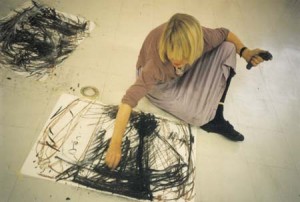
Deze foto toont een cliënt die zittend een oefening uit de methode ’t Tijdloze Uur doet.
Zij tekent met haar niet-dominante hand, waardoor haar gevoelskant meer aangesproken wordt.
In het dagelijks leven is ze geconditioneerd van uit linkshandigheid. In de andere hand houdt ze een stukje klei vast wat haar meer veiligheid en stabiliteit kan geven. Klei is een van de aller oudste stoffen op aarde en kan de bovenstaande gevoelens bekrachtigen. Door klei in de handen te voelen komt de cliënt beter in haar lichaamsgevoel. Daardoor kan ze ook spontaner haar diepere innerlijke beelden tot uitdrukking brengen in haar tekeningen.
Margareth Barten
2. Naqiba Bergefurt / naqiba@planet.nl
Kunstzinnig therapeut
Betreft: onderzoek in Amsterdam
Onderzoek naar de methode van ’t Tijdloze Uur die auteur Michiel Czn.Dhont in zijn boek beschrijft met betrekking tot de mogelijkheden voor kunstzinnige therapie; een case study betreffende de merites bij het voorkomen bij allochtone kinderen met ontwikkelingsproblemen.
Betreffende de auteur van dit onderzoek
Naqiba Bergefurt (1954) heeft pedagogie gestudeerd aan de Universiteit van Utrecht en heeft in verschillende locaties met kinderen gewerkt, zoals kinderen die speciale zorg nodig hebben en bij een ontwikkelingsproject in New Delhi.
Ze is autodidact in beeldende kunst, met name schilderen en heeft de opleiding kunstzinnige therapie gevolgd bij Annette Brederode in Amsterdam.
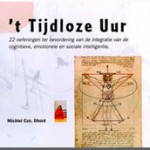
Ze heeft een opleiding gevolgd bij de kunststudio “Werkplaats Molenpad” in Amsterdam, opgericht door Michiel Czn. Dhont.
Met dit proefschrift rondt Naqiba haar opleiding aan het Kunstzinnig Therapeutisch Instituut in Utrecht af.
Over de onderzoeksgroep
Het onderzoek vond plaats op een basisschool waar meer dan 80% van de kinderen een allochtone achtergrond hebben. Al deze kinderen hebben taalproblemen en velen hebben ook sociaal-emotionele problemen als gevolg van het niet-geïntegreerd zijn in de Nederlandse cultuur.
De meisjes vertonen vaak een gebrek aan zelfrespect en zelfvertrouwen, wat resulteert in het zich terugtrekken uit of over-aanpassen aan de groep.
De jongens verbergen hun gebrek aan respect door herrieschoppen of onaangepast gedrag.
Planning van de sessies
De cursus bestond uit 9 lessen, elke week 1 uur, aan een groep van 5 kinderen in de leeftijd van 8 tot 10 jaar. Tijdens iedere sessie werd(en) één of twee van de oefeningen van de methode Michiel Dhont gegeven. De eerste drie lessen werden gebruikt als een soort diagnostische periode.
Daarna heb ik mijn keuze gemaakt voor het soort oefeningen op basis van de observaties die ik had gemaakt van de kinderen en de manier waarop ze met hun problemen omgingen.
Op dezelfde manier heb ik bepaalde aanpassingen gemaakt op de manier waarin de oefeningen worden aangeboden.
Ik gaf ze alleen maar individueel instructies, hoofdzakelijk op basisniveau. Er waren vijf tekenlessen en vier kleilessen.
Om ook het sociale aspect er bij te betrekken gaf ik ze aan het begin van iedere les een gezamenlijke warming–up.
Uitkomst van het onderzoek
Alle kinderen waren op één of andere manier uit balans.
De basis-tekenoefeningen zijn een zeer goed diagnostisch instrument om spanningen of gebrek aan structuur aan te tonen.
Bij twee kinderen zag ik teveel spanning (ook fysiek) en grote problemen bij het vinden van cohesie en innerlijke richting.
Aan het eind van de cursus werden beide kinderen meer ontspannen, rustig en meer zelf gericht.
Een ander meisje was te dik, erg passief en afhankelijk en toonde geen emotie of uitdrukking. Aan het eind was ze afgevallen, veel alerter, ze reageerde op haar eigen manier en ging voor haarzelf.
Het vierde meisje dat erg stil en beheerst was, brak door haar rolpatroon heen en rebelleerde en ontspande zich.
De enige jongen in de groep voelde zich gefrustreerd, wat meer te wijten was aan zijn tijdelijke situatie dan aan enig persoonlijkheidsprobleem (hij was pas in Nederland aangekomen). Hij was niet gemotiveerd om de therapie te volgen en stopte na vier keer. Zijn tekeningen lieten geen innerlijke beroering zien op de manier dat de tekeningen van de meisjes wel deden.
Nadat de jongen was vertrokken werden de meisjes meer ontspannen en hadden ze meer plezier in wat ze aan het doen waren!
Voor meer informatie over dit onderwerp/onderzoek kunt u mailen naar:
Naqiba Bergefurt/ naqiba@planet.nl
3. Silvia Fiorini / kunstzinnige therapeut / fiorini.silvia@gmail.com
Reactie van Kunstzinnig therapeut Silvia Fiorini op een workshop ’t Tijdloze Uur.
Enige tijd geleden heb ik tijdens de opleiding Kunstzinnige therapie in Leiden / Nederland een paar oefeningen in beeldende expressie gedaan die afkomstig zijn uit mijn ervaringen met de methode ’t Tijdloze Uur, tijdens een workshop op je atelier.
Ik heb er zelf heel veel aan gehad. Ze hebben mij geholpen in het nemen van belangrijke beslissingen.
Ik ben op dit moment stage aan het lopen in een school voor het speciale onderwijs Cluster 3 voor zeer moeilijk lerende kinderen. Ik heb je boek “t Tijdloze Uur.
Ik vraag mij af in hoeverre deze oefeningen toepasbaar zijn t.a.v. zeer moeilijk lerende kinderen en welke ervaringen zijn er op gedaan tot nu toe hiermee.
Ik ben van plan om een aantal oefeningen uit te proberen o.a. in combinatie met vorm tekenen. Eventueel kan dit een mooi onderzoekproject worden voor de scriptie die ik na dit stage jaar ga starten.
Zijn er verder scholingen hierover gericht aan het werken met kinderen? Ik moet zeggen dat het boek heel veel informatie geeft en ik geloof dat het een kwestie van experimenteren is.
Cursussen hierin kunnen extra enthousiast maken en inspiratie geven. Silvia Fiorini.
4. Luciette van Hezik / Kunstzinnig Therapeut / luciettevanhezik@zonnet.nl
Luciette werkt in een partnerschap en combineert verbale en/of lichaamstherapie met expressieve kunstzinnige therapie.
Beste Michiel,
Onderstaand mijn ervaring en visie met betrekking tot jouw methodologie.
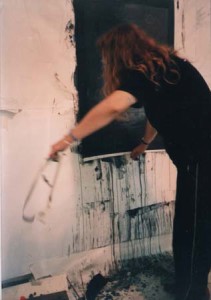
Expressief schilderen met beide handen in het verwerken van innerlijke spanningen. Vrouw werkt via beeldende expressie van uit beweging en intuïtie tijdens sessie.
Ik zal je een voorbeeld geven van het counselen van volwassenen, waarbij tekenen vanuit beweging en modelleren met klei verstrekkende resultaten hebben gehad via een combinatie met sociaal kunstzinnige therapie.
Bij een individuele counseling ontmoette ik een vrouw die het gevoel had in haar leven in een patroon vast te zitten, waarbij verbale therapie niet de gewenste resultaten opleverde.
Vanuit de basis beweging leidde ik haar naar de wiegende balansbeweging, waarbij
ze zelf de noodzaak voelde om naar “het schrift ”toe te werken, specifiek de staccato.
In de afwisseling van staccato en melodische beweging begonnen herinneringen en beelden naar boven te komen van een isoleercel waarin ze 16 jaar geleden tijd had doorgebracht nadat ze was opgenomen met een postnatale depressie.
Gevoelens van machteloosheid, verdriet en boosheid kwamen boven, maar ook haar uitdrukking van kracht, wat haar verbaasde en haar ook een bevrijd gevoel gaf.
Toen ik haar vroeg welk dier ze hierbij ervoer, gaf ze bescheiden een kat aan, maar in werkelijkheid was het meer een leeuw!
Via een opdracht vanuit expressieve kunstzinnige therapie om uit gele klei een leeuw te boetseren, is ze stap voor stap in staat geweest vorm te geven aan haar “ondergesneeuwde kracht” en heeft ze dit in haar dagelijks leven geïntegreerd.
Een andere mogelijkheid voor mij om de methode van Michiel Dhont te integreren is om mijn eigen individualiteit uit te drukken. Voor mijn proefschrift wil ik een onderzoek doen naar het effect van het gebruiken van beide handen evenals het gebruik van enkel de rechter- of de linkerhand bij alle visuele technieken van expressieve kunstzinnige therapie om de helften van de hersenen te stimuleren wat een complete harmonisatie van de mens in zijn helingsproces teweeg kan brengen.
Lees meer over het werk van Luciette
5. Josée van Schuppen / info: info@joseevanschuppen.nl en www.joseevanschuppen.nl
Beeldend kunstenaar en docent/therapeut methode ‘t Tijdloze Uur
‘Ik volgde diverse trainingen Beeldende expressie vanuit beweging en intuïtie bij Michiel. Dat was voor mij een openbaring.
Ik schilder sindsdien altijd met mijn handen die ik zie als instrument van mijn hart. Daardoor blijf ik dichter bij mijn gevoel en sta ik met beide benen op de grond’.
Josée: ‘Niets moet, alles is goed’.
‘action painting en het tekenen met gesloten ogen is een spannend avontuur en heerlijk om te doen. Als ik schilder of teken, vergeet ik alles om mee heen. Mijn schilderijen en tekeningen zijn meestal vol beweging en soms juist verstild. Ik verwerk vaak zand, touw of hout om mijn verbinding met de natuur te uiten. Ik geef regelmatig workshops ‘Leef je uit met verf’ met als motto: niets moet, alles is goed.
Ik merk regelmatig dat zowel volwassenen als kinderen te veel moeten van zichzelf en de omgeving. Dat vindt ik jammer, want het streven naar resultaat zet vaak een rem op de creativiteit.
Ik denk dat ik een werk wat ik net gemaakt heb ‘t Tijdloze Uur noem. Het grappige is dat ik meestal 1 uur schilder per keer en dan lijkt het 5 minuten’.
6. Cas Rooseboom teaching in Kenya / Africa with ‘the Timeless Hour’ / cas@casrooseboom.nl
Cas werkt al gedurende jaren met perioden in Kenia en Tanzania. Daar leidt hij basisschool groepsleerkrachten en kunstenaars op mede van uit de methode ’t Tijdloze Uur.
Daarnaast werkt hij in de krottenwijken van grote steden als Nairobi met straatjongeren.
Werkelijke creativiteit bevordert het gevoel van eigenwaarde en het vermogen zelfverantwoordelijkheid in nieuw en positief gedrag om te zetten. Een kort verslag van een voorbeeld in de praktijk waar Cas over vertelt:
‘Een jongen in een achter wijk had een cursus van mij gevolgd (zie de foto’s). Een jaar later kom ik diezelfde jongen tegen in Nairobi, midden op straat en nu in geheel nette kleren. Ik spreek hem aan en vraag hem wat hij doet sinds het vorig jaar. De jongen vertelde me dat hij er achter was gekomen zelf iets te gaan ondernemen. Door initiatief te nemen was hij naar een bedrijf gestapt voor het krijgen van werk. Dat was gelukt en de jongen had voor het eerst zijn eigen geld verdient bij dat bedrijf.
Letterlijk bleek dit het resultaat van de ervaringen via de beeldende sessies van het jaar daarvoor in de cursus aan die groep jongens’.
7. Gerard Dirks / gerarddirks@hotmail.com
Gerard Dirks is de basisschool groepsleerkracht en directeur van de school waar de YouTube film werd opgenomen die bij het boek geleverd wordt op DVD.
Hij is de leerkracht die vanwege zijn ervaringen met ’t Tijdloze Uur terug ging naar zijn werk als therapeut van Autistische kinderen.
Gerard Dirks:
“Vanuit mijn 25 jaar ervaring als basisschool -onderwijzer en -manager beveel ik het boek ’t Tijdloze Uur aan. Het helpt de persoonlijkheid van kinderen te ontwikkelen. Het is een extra en basisdimensie.
Van uit mijn ervaringen door de samenwerking met Michiel Dhont opgedaan met de methode van ‘t Tijdloze Uur, heb ik besloten weer terug te keren naar mijn oorspronkelijke werk als begeleider van autistische kinderen. Daar ga ik van uit deze methode weer met autistische kinderen werken’.
‘Twee meisjes in basisschool groep 7/8 bezig met het uitwisselen van elkaars kleibolletje. Voelen van verschillen van gewicht, vochtigheid, temperatuur en volume van elkaars kleibolletje. Ervaringsgerichte oefening in communicatie op speelse manier.
Ook wisselden de meisjes de kleibolletjes tot circa 6 a 8 keer uit tijdens deze oefening met andere kinderen uit de klas. Steeds ervaren ze de verschillen.
Het vroegtijdig ontdekken van onderlinge overeenkomsten en verschillen maakt dat kinderen op jonge leeftijd om leren gaan met onderlinge verschillen via speelse oefeningen. Dit kan bijdragen aan het op latere leeftijd voorkomen van discriminatie t.a.v. verschillen binnen een pluriforme etnische samenleving.
8. Joke Zonneveld / beeldend kunstenaar en docent werkt in samenwerking met Irma Vroegop met kinderen van 4 tot 12 jaar
meer informatie op www.jokezonneveld.nl en www.ikvolgje.nl

Joke:
‘Dit zijn foto’s van sessies met kleine kinderen in mijn eigen atelier en ook op een basisschool. Daarbij heb ik op vele manieren diverse oefeningen van uit de methode ’t Tijdloze Uur toegepast. De kinderen in haar groepen begeleid ze in beeldende expressie van uit beweging en intuïtie dat processen zijn waarbij de kinderen veelal spanningen van stress kunnen loslaten en hun concentratie vermogen daarom versterken. Ik zie dat kinderen daardoor vrijer, meer empathisch en creatiever in gedrag worden’.
Joke Zonneveld geeft bovendien basisschoolklassen de mogelijkheid een dagdeel in haar atelier in Uithoorn te komen en gebruikt daarbij de oefeningen uit ’t Tijdloze uur.
Geweldloze Communicatie
In samenwerking met Irma Vroegop biedt ze de mogelijkheid aan op school zelf voorbereidende lessen te geven rond hetzelfde thema, gekoppeld aan oefeningen rond ‘Geweldloze Communicatie‘ .
In beide activiteiten speelt het los komen van het oordeel een grote rol.
Daarnaast geeft ze ook schilderles aan volwassenen, waarbij de oefeningen uit het ‘t Tijdloze Uur een belangrijke plek innemen.
Meer informatie op www.jokezonneveld.nl en www.ikvolgje.nl
Reactie van een leerkracht op onze activiteit:
Ik merkte vandaag tijdens het tekenen dat de kinderen minder vaak de woorden ‘mooi of lelijk’ gebruikten. Ze kunnen nu meer hun fantasie tekenen zonder hierbij meteen een oordeel te geven. Voor mij als leerkracht geldt dat ik het heel erg leuk vond om te zien hoe sommige leerlingen die normaal gesproken weinig opvallen, of op en negatieve manier, nu juist heel leuk bezig waren. Kinderen die normaal gesproken druk zijn, faal angstig, of zich slecht kunnen concentreren, waren nu juist heel leuk aan het werk. Leuk om die kinderen ook eens echt gemeende complimentjes te kunnen geven, en hen in het zonnetje te zetten.
7 de klei laten wakker worden / ‘let the clay become awake’
15 diepe aandacht / ‘deep concentration’
20 de klei voelen / ‘to feel the clay’
21 de veilige plek / ‘a safe place’
40 aan het tekenen / ‘go and draw’
kortom een fijne herinnering aan een prachtige les proces in ‘ervaringsgericht leren’
9. Een onderzoek in opdracht van het Instituut van Kind & Recht te Amsterdam
Annette Jasperse / voormalig student van het atelier Werkplaats Molenpad van Michiel Czn. Dhont
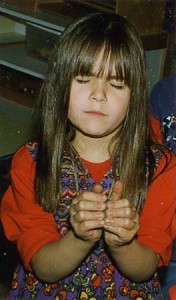
Annette Jasperse / annette.j@daxis.nl / docent beeldende kunst en werkend met de methode
’t Tijdloze Uur
Zes weken met een middagsessie van drie uren heeft Annette Jasperse met supervisie van mij een onderzoek gedaan naar de vraag van de rechter; ‘kan en mag de dochter van de gescheiden vader die alleen elders woont haar vader bezoeken’?
Dit is een recht dat de elke vader in principe na scheiding heeft. De rechter gaf het Instituut Kind & Recht de opdracht dit helder te maken aan de hand van onderzoek.
Uit de drie eerste gezamenlijke tekensessies op het adres van Kind & Recht met de moeder, nieuwe vriend, broertje en het meisje van 6 jaar werd al het e.a. duidelijk.
Bij de laatste drie klei- en tekensessies, waarbij het betreffende meisje alleen met Annette was, gaven zowel de kleisessie als alle tekeningen en de dialoog tussen het meisje en haar gemaakte tekeningen een nog veel duidelijker beeld na observatie.
De uiteindelijke beoordeling, tot stand gekomen door samenspraak tussen de directrice van het Instituut Kind & Recht, Annette en mij, leidde tot een negatief advies aan de rechter.
De diagnose via de methode ’t Tijdloze Uur had de rechter overtuigd. De uitspraak van het vonnis luidde dat de vader geen bezoek en ontmoetingsrecht kreeg toegewezen t.a.v. zijn dochter in het licht van eerder getoond onverantwoord gedrag.
10. Hanneke Dingemans
De ervaring van een student op het atelier van de Werkplaats Molenpad, via een van de beeldende sessies uit ’t Tijdloze Uur.
Enige jaren voordat ik bij Michiel kwam schilderen had ik een kunstzinnig therapeutische opleiding gevolgd. Via kunstzinnige processen heb ik daar niet direct in contact kunnen komen met mijn eigen innerlijke beelden. Daar was niet de ruimte voor binnen het opleidingstraject.
Het was dan ook een verademing de vrijheid van schilderen te ervaren van de methodiek van ’t Tijdloze Uur’. Alles is volgens Michiel in oorsprong goed zoals ik het tot expressie heb gebracht!
Een van de meest opmerkelijke gebeurtenissen speelden zich als volgt af:
Wij kregen door Michiel op het atelier een specifieke oefening aangereikt die het Archaïsche schrift heet. Na het schrift maakten we allemaal ook nog een tekening met gesloten ogen, waar we naderhand met geopende ogen aan door konden tekenen.
Bij de oefening werd muziek gedraaid die bestond uit ritmische oer geluiden met zang, verschillende klanken en trommels.
Aan het eind van deze sessie werd dit tekenproces door alle studenten één voor één geëvalueerd via de dialoog met onze tekeningen. In mijn dialoog met mijn pas gemaakte serie tekeningen kwam de vorm en betekenis van een krachtdier naar boven. In dit geval verscheen als krachtdier de ‘Poolhond’. Binnen het sjamanisme is het krachtdier een bekend verschijnsel waarbij de mens zich spiegelt en kracht ervaart aan een bepaald dier. Dit is ook bekend verschijnsel uit de droomwereld.
Voor mij was het Sjamanisme tot die tijd een ongekende visie en had ik me er nooit in verdiept. Misschien wel eens over gehoord maar eigenlijk ook iets waarbij ik een soort van grensoverschrijdende niet te beredeneren angst ervoer terwijl ik me wel heb verdiept in Astrologie, chakra’s en vele andere esoterische onderwerpen.

Tijdens de eerder geschetste schilder activiteit kwam ik echter moeiteloos in contact met een witte poolhond, waarbij ik een vaag gevoel had van; “dit zal dan wel mijn krachtdier zijn”.
Gedurende de daaropvolgende weken heb ik hier weinig aandacht meer aan geschonken tot ik met een vriend in Amsterdam over een maan overgoten kade liep richting een concert van de jazz formatie O.BA.O waar Michiel als contrabassist in speelt. Op die kade liep een echtpaar ons tegemoet met een klein wit poolhondje dat mij in het voorbijgaan deed herinneren aan het moment van het teken proces op het atelier van Michiel.
Echter wat mij tot op heden het meest bezig heeft gehouden was weer enige weken later de vraag van dezelfde vriend nota bene of ik een weekje op een hond wilde passen. Hierbij moet ik misschien opmerken zelf nooit een hond te hebben gehad en hier ook geen uitgesproken voorkeur voor heb.
Ik wist tot het moment dat de hond bij mij binnenkwam niet wat voor hond het zou zijn en schrok een beetje toen ik hem zag……een grote witte Samojeed of Poolhond. Mijn krachtdier was naar mij toegekomen om me te ontmoeten. We hebben een week samen opgetrokken. Het heeft veel voor me betekend.
Dit is het vervolg op mijn ervaring met de Poolhond; synchroniciteit
Enige tijd later.....het zal misschien wel zo'n 2 jaar zijn geweest...kwam het boek 'De Tzolkin' op mijn pad. De Maya's waren in staat de samenhang tussen het universum de aarde en de mensheid te ervaren. Dit is weergegeven in een energetische matrix 'De Tzolkin' genoemd. Deze matrix zorgt voor de verbinding van een ieder van ons met het universum als weefpatroon van de schepping dat los staat van tijd en ruimte. Toen ik opzocht in de matrix wat mijn "Kin" is, bleek ik een White Magnatic Dog te zijn waardoor mijn lijntje met de witte poolhond als krachtdier werd bevestigd. Zo komt alles samen!
Toevoeging door Michiel Czn. Dhont
Door beeldend intuïtief te werken aan tekeningen en schilderingen via de methode van ’t Tijdloze Uur (in dit geval van uit de oefening het Archaïsche Schrift) ontwikkelt zich een creatieve stroom van uit het onbewuste die geleidelijk aan kan uitmonden in een meer bewuste beleving en/of herkenning, zoals in deze gebeurtenis met de Samojeed of Poolhond.
In het boek het Slimme Onbewuste van Ab Dijksterhuis wordt haarscherp aangetoond dat het onbewuste weten een enorme krachtbron is en betekenis geeft. Kwaliteitsbeleving en geestelijke helderheid kan het menselijk bestaan verdiepen en verrijken en in balans brengen.
11. Rachel Frankenhuis / Creatief Therapeut en docent – (o.a. asielzoekerskinderen) / rachelfrankenhuis@planet.nl
Omdat leerkrachten constateerden dat veel asielzoekerskinderen tussen de 4 en 7 jaar gedrags- en emotionele problemen vertonen, heeft Pharos voor de onderbouw van de basisschool Applaus voor jezelf ontwikkeld.
12. Jos Albas / een ervaring van een student van Michiel Dhont
‘tijdloos werken zorgt voor energie en passie’.
In 2005 maakte ik na jaren weer contact met mijn eigen beeldend vermogen bij beeldend kunstenaar Michiel Dhont. Het creatieve beeldend proces van uit beweging en intuïtie dat toen is aangeboord vormt nu een fundament in mijn levenswijze. In 2010 heb ik opnieuw een beeldende cursus gevolg van uit beweging en intuïtie bij Michiel Dhont.
Het beeldende proces is voor mij een schitterend medium dat in veiligheid ruimte bied aan het exploreren van de emoties in mijzelf.
Ik heb ervaren dat ik met heel mijn lijf, via mijn handen beeldend contact kan maken met de emotie van wat er op dat moment speelt. Het aanbieden van diverse meditatievormen, beeldende oefeningen en groepsdynamieken, heeft mij bewust gemaakt van de invloed op mijn eigen beeldend proces.
Door regelmatig afstand te nemen van mijn beeldende dynamiek heb ik tijdens het beeldend werken mijn emoties zien veranderen. Tijdens die afstand kon ik door middel van de dialoog met mijn beeld en via de begeleiding van Michiel Dhont in een proces van transformatie gaan.
Tijdens de dialoog met mijn beeld en door deze transformatie ontstaat er bij mij ruimte, helderheid, inzicht en bewustwording op allerlei niveaus.
Tenslotte heeft het maken van de Mandala in combinatie met het Medicijnwiel op het strand in Griekenland, mij diep geraakt.
Bij het creëren van de Mandala heb ik oude lasten en belemmeringen een plek kunnen geven en mijn wens tot bewustzijn ontwikkeling in de wereld gezet. Ik heb de eenheid in vorm en het proces van de verbeelding van de Mandala als een zeer krachtig en zuiverend ritueel ervaren met een grote potentie om in het reine te komen met mijn lichaam en geest.
De vernieuwde helderheid en inzichten geven mij energie en passie, zij vormen de pijlers waaraan ik reflecteer en handel tijdens mijn dagelijks leven thuis, mijn sociale omgeving en tijdens het werk.
Mijn dank is groot dat ik dit zo heb kunnen beleven en ervaren. Een warme groet, Jos.
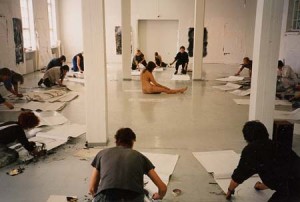
atmosfeer
13. Karel Kindermans / karel@kindermans.nl
Docent modeltekenen aan de hbo Willem de Kooning Academie in Rotterdam.
Hieronder de vermelding van ervaringen opgedaan met de beeldende processen uit ’t Tijdloze Uur, door de docent Karel Kindermans aan de Willem de Kooning Kunstacademie in Rotterdam.
Ook al is het geen therapeutische zetting op deze kunstacademie, des te meer blijkt hoe en op welke wijze de beeldende processen mensen een inzicht in zichzelf kunnen geven en hun creatieve levensenergie kunnen ontdekken en hun vermogens uitbreiden en verdiepen.
Anders dan anders
‘Dit was het moment, halverwege de module waarop men van het krappe pad was afgeraakt om terecht te zijn gekomen in de weide’.
Karel:
‘Tijdens een module modeltekenen op het hbo van de Willem de Kooning Academie, kreeg ik studenten voor me met een grote diversiteit aan studie-achtergronden. In de groep zaten studenten verpleegkunde, communicatie, bedrijfskunde, leraren geschiedenis… enzovoorts bij elkaar.
De filosofie van de hbo-opleiding was dat studenten ook studiepunten konden krijgen met modules naar vrije keuze, die niets met hun reguliere studie te maken hadden. Hoe kun je in 10 lessen van 1,5 uur studenten leren modeltekenen? Studenten werden geacht 56 uren te besteden aan een module en kregen daarvoor twee studiepunten.
Ik moest hen dus motiveren ook thuis veel meer tijd te besteden dan men deed in les verband. Ik had twee stellingen als argumenten om studenten te overtuigen.
Argument 1: je kunt niets leren in uitsluitend 15 contact-uren. Ook het rijbewijs haalt niemand in 15 lessen.
Als studenten konden ervaren dat modeltekenen niet een lange smalle weg was met een enkel denkbaar resultaat had ik het goed gedaan. Modeltekenen is een grote speelweide waarin onderzoek leidt tot verrassende en ondenkbare resultaten. En passant ontwikkelt men oog voor kunstenaars die amper met elkaar zijn te vergelijken zoals Egon Schiele en Henry Matisse. Als je deze toch gaat vergelijken, dan weet je dat je tot de speelweide bent doorgedrongen.
Ik gaf de eerste vijf lessen tools in handen die alle afzonderlijk de studenten leerden kijken. De magie was dat de studentes verpleegkunde het lichaam secuur observeerden en de studenten bouwkunde (vaak onhandige tekenaars) geen enkel probleem hadden met de meest ingewikkelde poses wanneer ze die mochten vertalen in dozen en bollen.
De laatste tool die ik aanreikte voordat ze zelfstandig konden experimenteren was geïnspireerd op ‘t Tijdloze Uur.
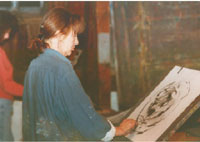
Blind raken: een experiment met tekenen met de niet dominante hand en met gesloten ogen.
Ik vertelde dat als ik blind zal raken, ik als fervent tekenaar niet zou stoppen. Ik zou doorgaan, omdat tekenen ook te maken heeft met iets dat mijn lichaam lekker vindt. Resultaten raakten deze les op de achtergrond.
Tekenen deden de studenten met ogen dicht of met de andere hand dan die waarmee ze bij voorkeur werkten. Loslaten was de enige vraag en zij die zich daaraan overgaven, ontdekte dat ze bijvoorbeeld met verhoudingen geen enkel probleem meer hadden.
De groep studenten die met deze tool niet tot zijn recht kwam had buitengewoon veel moeite met loslaten en het frustreerde dat anderen deze mysterieuze les voortgang boekten. Ze mochten na een uur hun pogingen staken om het op een voor hun vertrouwde manier te doen en sommigen kon ik via de achterdeur toch weer binnenhalen. Want ze vonden het frustrerend dat ze niet konden loslaten, maar waren niet onwelwillend’.
‘Dit was het moment, halverwege de module waarop men van het krappe pad was afgeraakt om terecht te zijn gekomen in de weide’.
Karel Kindermans / karel@kindermans.nl
—–
14. Een Ode aan het belang van de doorstroming via de hersenbrug van de Linker en Rechter Hersenhelft
A research: My Stroke of Insight / Dr. Jill Bolte Taylor
Een wereldberoemd onderzoek naar een casus van een neurologisch ziektebeeld bij een Amerikaans Neuroloog Dr. Jill Bolte Taylor
Dr. Jill Bolte Taylor, the Singin’ Scientist
My Stroke of Insight is a New York Times Bestseller and is published by Viking Penguin Group. You may order a copy through online stores including Amazon and Barnes & Noble, or ask your local bookstore. It is available in hardcover, audio, and large-print edition.
Jill Bolte Taylor was a 37-year-old Harvard-trained and published brain scientist when a blood vessel exploded in her brain. Through the eyes of a curious neuroanatomist, she watched her mind completely deteriorate whereby she could not walk, talk, read, write, or recall any of her life. Because of her understanding of how the brain works, her respect for the cells composing her human form, and an amazing mother, Jill completely recovered her mind, brain and body. In My Stroke of Insight: A Brain Scientist’s Personal Journey, Jill shares with us her recommendations for recovery and the insight she gained into the unique functions of the right and left halves of her brain. Having lost the categorizing, organizing, describing, judging and critically analyzing skills of her left brain, along with its language centers and thus ego center, Jill’s consciousness shifted away from normal reality. In the absence of her left brain’s neural circuitry, her consciousness shifted into present moment thinking whereby she experienced herself “at one with the universe.”
Based upon her academic training and personal experience, Jill helps others not only rebuild their brains from trauma, but helps those of us with normal brains better understand how we can ‘tend the garden of our minds’ to maximize our quality of life. Jill pushes the envelope in our understanding about how we can consciously influence the neural circuitry underlying what we think, how we feel, and how we react to life’s circumstances. Jill teaches us through her own example how we might more readily exercise our own right hemispheric circuitry with the intention of helping all human beings become more humane. “I believe the more time we spend running our deep inner peace circuitry, then the more peace we will project into the world, and ultimately the more peace we will have on the planet.”
My Stroke of Insight (Viking) is available at your local bookstore or online merchants including Amazon and Barnes & Noble.
For rights to My Stroke of Insight, please contact Ellen Stiefler by e-mail: Info@AmicusAgency.com or phone: 858-756-5767.
For press inquiries, please contact Louise Braverman, at louise.braverman@us.penguingroup.com.
For speaking engagements, please contact Dr. Katherine Domingo, at kat@mystrokeofinsight.com.
We have set up a forum for people who want to build a community around the ideas presented in the best-selling book. There is a forum for people who have experienced stroke or other medical issues first-hand or through a loved one; another forum focuses on techniques for how to achieve a balanced brain; and yet another allows people to share their stories of insight and the life lessons they have learned. These forums can be found on the website, www.mystrokeofinsight.com. Read beautiful stories and learn more about the ideas presented in My Stroke of Insight.

